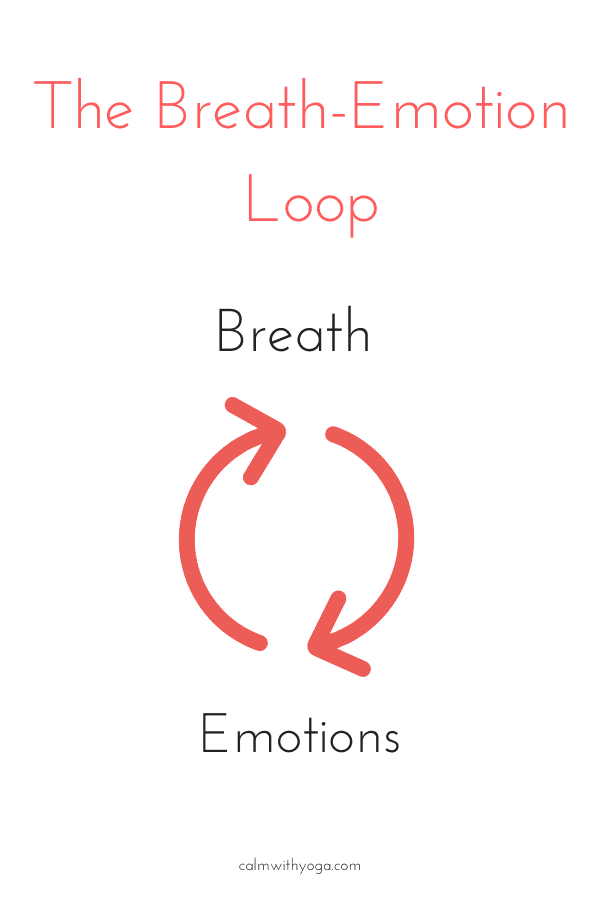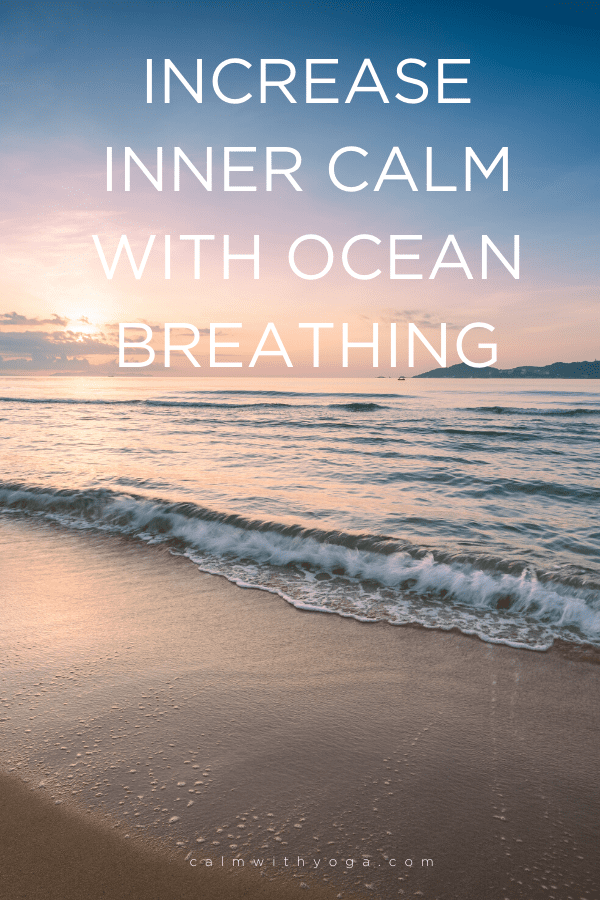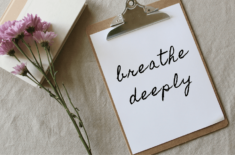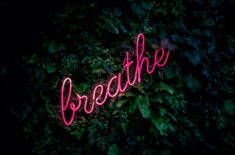Calm is retained by the controlled exhalation or retention of the breath.
– Sutra 1.34, Book 1, Yoga Sutras of Patanjali
I used to struggle with chronic panic attacks.
They’d come on suddenly and out of nowhere and would leave me gasping for air.
It was this feeling of not being able to breathe that led me to study my own breathing.
I was so freaked out by the experience of not being able to catch my breath that I knew I needed to learn how to regain control of it.
So I started observing my breathing at different points throughout the day.
If I was feeling anxious, I’d notice my breath and find that it was short and shallow.
If I was feeling afraid, I’d notice my breath and find that it was short and shallow.
If I was feeling angry, I’d stop and notice my breath and find that it was short and shallow.
I noticed that my breath was deep, even, and long after practicing yoga or during deep meditation.
I soon realized that my breath could be my ally or my foe, depending on who was in control at that moment – me or it.
Using the breath to conquer difficult emotions:
When the breath wanders the mind is unsteady.
But when the breath is calmed, the mind too will be still.
-Hatha Yoga Pradipika
When our emotions are heightened, such as when we’re stressed, overwhelmed, or fearful, it can feel like our breathing gets hijacked and we lose control.
We then scream or yell, or blow up at our kids or partners only to later regret it.
The good news is you can use your breath in the heat of the moment before you explode.
And even better – we can teach our kids to use their breath to ride the waves of intense or uncomfortable emotions, too.
Breath and emotions are intimately tied together; they impact one another and form what I like to call the Breath-Emotion Loop:

Breathing rhythms send messages to your body that affect your mood, your stress levels, and even your immunity.
The way you breathe can literally change your emotional and mental state.
If you breathe fast and shallow, your brain’s arousal center becomes overactive.
This can lead to increased alertness, wakefulness, excitement, or anxiousness.
If you breathe slow, deep, and long, you’ll become calmer because the arousal part of your brain isn’t being activated. (1)
Conversely, our breath automatically responds to our emotional shifts.
Emotions cause changes in the body, and breathing is one of the bodily processes most impacted by emotions. (2)
Yogic researcher Dr. Ananda Balayogi Bhavanani explains it like this:
“Emotions and breath are known to have a deep relationship.
Animals such as the rat and rabbit have fast breathing and so are extremely nervous, mentally unstable, emotionally restless, and live only for a short period of time.
In contrast, the elephant and turtle are slow, deep breathers and consequently have calmer personality and longer lives.”
So how can we make our breath our ally in moments of stress and emotional chaos?
By simply observing and becoming aware of our current breathing pattern, we can break the cycle and take back control.
Once we realize that our breathing has been hijacked (i.e.: we’re breathing short, shallow, and erratic) we can choose to consciously switch gears.
Switching gears with pranayama:
The mind is the king of the senses, but the breath is the king of the mind.
– Hatha Yoga Pradipika
Yogis have known for thousands of years that we can shift our mood, energetic state, and emotions by changing the breath.
This is what the practice of pranayama is all about.
The Sanskrit word ‘pranayama’ means ‘regulation of life force energy via the breath.’
Yogic breathing exercises help to infuse vital energy into the lungs because with each inhalation we’re taking in prana (fresh air) and with each exhalation, we expel apana (stale air.) (3)
If you’ve ever practiced ashtanga or vinyasa yoga you know how important the breath is in order to generate internal body heat and mental focus.
Yoga classes that focus on blending asana practice (poses), intentional breathing and conscious awareness tend to be highly addictive because the merging of movement, breath, and mind creates a “yoga high” that leaves you feeling like you hit the reset button.
And now you can practice yoga off the mat by committing to your own pranayama practice at home… I’ll show you how below. 🙂
Here are some proven health benefits of consistent and regular deep breathing/ pranayama practice: (4)
– Increase resilience in coping with stress, anxiety, anger, and depression effectively
– Regulate emotions
– Balance the nervous system
– Decrease stress response
– Help manage panic attacks
– Increase rest/ digest/ relaxation/ regeneration response
– Regulate blood sugar levels
– Lower cholesterol
– Regulate blood pressure
– Improve sleep cycle and quality
– Improve digestion
– Improve respiratory function
–Improve focus and concentration
Using Ocean Breathing to take control:

Resistance to breathing is resistance to change.
Resistance to change is resistance to living.
Resistance to living is a kind of walking death.
– Max Strom, “A Life Worth Breathing”
I’ve used many effective breathing techniques throughout the years but my go-to has always been Ocean Breathing.
There’s something really nurturing about the sound of ocean waves ebbing and flowing from within me.
When I close my eyes and get really into it it becomes like a little meditation session.
The Ocean Breath is also known as Ujjayi pranayama and victorious breath.
With Ujjayi breathing, there’s a slight constriction at the back of the throat which results in a hissing sound that sounds a bit like Darth Vader in Star Wars.
Benefits of Ujjayi (Ocean Breath):
When you couple Ocean Breathing with deep breathing, you increase your rest/ digest/ relaxation/ regeneration response because you stimulate your Vagus nerve, a key nerve that passes from the base of your brain, down your face and throat, down to your gut. (5)
Sustaining focus on the sound of your breath while practicing Ocean Breathing will make it easier to concentrate and silence the mind’s chatter.
Multiple studies suggest Ujjayi can be effective in working with anxiety, insomnia, and PTSD. It’s been successfully used with Vietnam veterans (6) and natural disaster victims. (7)
The wave-like sounds of this breathing technique can provide you with some much-needed soothing in the middle of heightened moments or emotional chaos.
Just a few minutes of Ocean Breathing breathing offers a welcomed sense of control as well as waves of calm grounded energy.
So let’s try it, shall we?
HOW TO:
1 – Sit comfortably and with the back upright.
2 – Take a deep breath in through your nose for 5 counts by expanding your lower belly as your lungs fill with air. (Keep your chest and upper body still.)
3 – Hold the air in for a count of 3.
4 – Slowly exhale all the air out through your nose for 7 counts (your lower belly will now contract inwardly towards your spine as your lungs empty of air… Again, do your best to keep your chest and upper body still.)
5 – Breathe normally.
6 – Relax your shoulders, neck, jaw, mouth, eyes.
7 – Place the tip of your tongue at the roof of your mouth and keep it there for the remainder of this pranayama. (*There are nerve endings in the roof of your mouth that can activate the calming side of your nervous system.)
8 – Close your eyes.
9 – Inhale through your nose for a count of 5 and tighten the back of your throat to produce the sound of an ocean wave (remember to engage your lower belly and keep your upper body still.)
10 – Exhale through your nose for a count of 7 while tightening the back of your throat to produce the sound of an ocean wave (remember to engage your lower belly and keep your upper body still.)
11 – Keep inhaling and exhaling just like this and bring your awareness to the sound of the waves emanating from within you. Keep your awareness on the ocean sound and feel the waves of vital energy ebbing and flowing inside you.
12 – If a thought comes, let it come… feel it fade as you return your awareness to your inner waves.
13 – Keep this breathing pace of inhaling for 5 and exhaling for 7 for at least 10 rounds (2 minutes.)
The more the better when it comes to increasing inner calm.
Consistency is the key to really reaping the full range of mental, emotional, and physical benefits of this ancient practice.
Use this technique whenever you feel any uncomfortable or confronting emotion.
Consider it off-the-mat yoga practice.
Creating the habit of using this tool at the moment can really save you lots of vital energy and inner resources instead of spinning your wheels.
Your breath is something you have with you at all times, no matter what.
It also happens to be a tried and tested (and proven) tool to help you deactivate your inner stress alarm while also activating your innate soothing and healing systems.
Take advantage, it’s 100% natural and free.
On average we take anywhere from +/- 17,000 – 23,000 breaths each day.
What if you dedicated just 20 of those breaths to a daily Ocean Breathing practice?
What might happen if you learn to surf your inner waves?
How can this simple breathing exercise help your family?
Try it with your kids and notice the positive impact it can have on them.
REFERENCES
:
(1)http://time.com/4718723/deep-breathing-meditation-calm-anxiety/
(2)https://www.ncbi.nlm.nih.gov/pubmed/18487316
(3) Strom, M., (2010) A Life Worth Breathing. Skyhorse Publishing
(4) https://motherhoodcommunity.com/use-yogic-breathing-stress-anxiety-relief/
(5)https://www.youtube.com/watch?v=VAL-MMYptQc
(6)https://www.researchgate.net/profile/Patricia_Gerbarg/publication/259079108_Multi-Component_Yoga_Breath_Program_for_Vietnam_Veteran_Post_Traumatic_Stress_Disorder
(7)https://www.ncbi.nlm.nih.gov/pubmed/22398351












